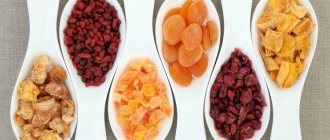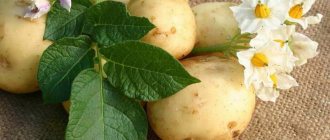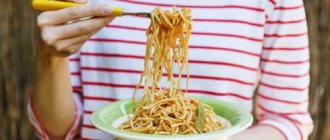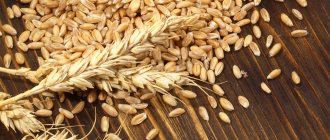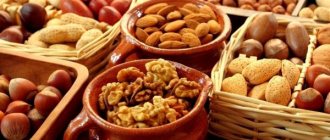What is included in the composition of black Darnitsa bread according to GOST? The benefits and harms of this flour product
In almost all grocery stores and hypermarkets you can find Darnitsa bread in the bakery departments.
This type of bread is in great demand due to its excellent taste and health benefits.
Next, consider the quality criteria when choosing Darnitsa bread, the nutritional value and calorie content of this product and the effect on the body.
Dear readers! Our articles talk about typical ways to resolve legal issues, but each case is unique.
If you want to find out how to solve your particular legal problem, please use the online consultant form on the right or call. It's fast and free!
Nutritional value of different types of bread
On the shelves of our stores you can find many types of bread. Are they all the same in composition and energy value? Of course not.
Rye bread contains 215 kilocalories per 100 grams. This bread is most often recommended during a diet due to its relatively low calorie content. Borodino bread is also allowed on a diet. Its calorie content is 200 kilocalories per 100 grams. Darnitsky bread has a comparable energy value - 210 kilocalories.
White bread of all varieties has a higher calorie content due to the increased content of carbohydrates and fats. Thus, a sliced loaf contains 265 kilocalories per 100 grams, wheat bread – 240 kilocalories. White bread is not always completely excluded during a diet, but it should only be eaten by those who cannot tolerate rye bread for some reason.
Grain bread is becoming increasingly popular in the diet. The calorie content of grain bread of different varieties is 220-250 kilocalories. It is made using whole cereal grains, which makes this type of bread incredibly rich in vitamins and microelements. Whole grains are digested very slowly, so this type of bread during a diet helps fight increased appetite and prevent overeating.
History of appearance
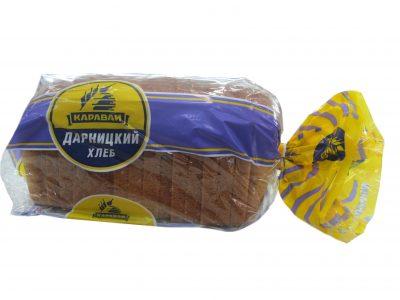
People usually call it a “brick” because of its corresponding shape.
The product appeared a long time ago, in the last century. By mistake, many claim that Darnitsa black bread was first made in the Kyiv province of Darnitsa, where the name came from. This version is wrong.
Real Darnitsa bread according to a traditional recipe was made in the Leningrad bakery plant No. 11 in the distant 30s. To this day, the original recipe has been preserved and baked goods are produced according to its requirements. Minor changes have been made: yeast can be added instead of sourdough.
How many calories are in fried white and black bread?
| The product's name | Squirrels (g.) | Fat (g) | Carbohydrates (g) | Calorie content of a piece per 100 g. |
| Fried white bread | 1,3 | 20,2 | 74,1 | 330 |
| Fried black bread | 1,2 | 20,2 | 75,2 | 320 |
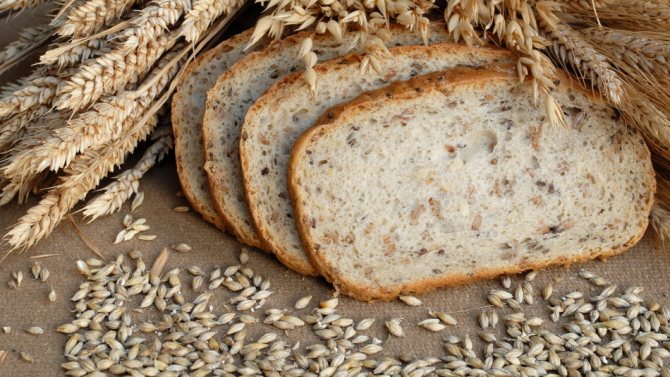
Bread and butter, fried and toasted: nutritional information
Quality standards (GOST)
The main document regulating the requirements for the composition of Darnitsa bread and the quality indicators of the main ingredients is GOST 26983-86 “Darnitsa bread. Technical conditions".
According to GOST rules, high-quality Darnitsa bread is prepared from the following components:
- a mixture of rye flour (60%) and 1st grade wheat flour (40%);
- yeast at the rate of 5 g per kg of flour mixture;
- salt no more than 15 g per kg of flour mixture.
There are a number of other state standards regulating the requirements for taste and appearance:
- "Bakery products. Method for determining porosity."
- "Bakery products. Methods for determining acidity".
- “Bakery products in packaging. Technical conditions".
Composition of Darnitsa bread
The recipe for Darnitsa bread was created back in the distant Soviet years at the Leningrad plant No. 11, famous at that time, and later GOST 26983-86 appeared, which adhere to these standards to this day. Composition of Darnitsa bread:
- Natural starters
- 1st grade rye flour
- 1st grade wheat flour
- Salt
- Water
To recognize true Darnitsa bread after tasting a slice, you should feel a fermented but pleasant taste, a characteristic warm and appetizing aroma. The slice should have a noticeable fine-grain structure.
Nutritional value and calorie content

The calorie content of flour products is low compared to other varieties: 206 kcal per 100 g of product.
The low calorie content is associated with a reduced proportion of wheat flour and an increased proportion of rye flour.
Ratio of proteins, fats and carbohydrates in grams (per 100 g of product): 6.5/1.2/41. The fat content is minimal when carbohydrates are saturated.
How many calories are in toast made from white and brown bread?
| The product's name | Squirrels (g.) | Fat (g) | Carbohydrates (g) | Calorie content of a piece per 100 g. |
| Toast bread | 7,3 | 3,9 | 52,5 | 200 |
| Toast | 8 | 4,2 | 55 | 300 |

Detailed calorie content of bread
Supplements
A real flour product prepared in accordance with GOST should not contain food additives, dyes, preservatives, or palm oil . GOST requirements strictly determine the composition of “correct” baked goods.
Manufacturers can add other components to ready-made mixtures for baking bread at home - GOST requirements do not apply to them. Frequently used additives for ready-made flour mixtures (for Darnitsky bread):
- improvers consisting of malt, citric and ascorbic acids - allow you to give the finished baked goods airiness and porosity, a neat appearance;
- caramel coloring - allows you to give the finished product an appetizing crust with a rich gray-brown tint.
Quality criteria when choosing Darnitsa bread
When choosing a flour product in a store, you should focus on appearance and expiration dates. It is important to consider the criteria for “correct” Darnitsa bread:

the shape of the product must be oval or round, or oblong-oval;- the crust is rough, there should be no large cracks or dents;
- color - brown, with a grayish tint, hearth bread will be darker;
- The presence of burnt crusts and foreign inclusions in the form of spots and dots is not allowed;
- the surface should be dry, not sticky, without a feeling of moisture;
- The aroma is pleasant, bready, without a hint of mold.
Effect on the body: benefits and harms
Darnitsa bread, when consumed wisely, is beneficial for the body. The product contains not only vitamins (B1, B12, PP, E), but also minerals (selenium, iron, copper, sodium).
Benefits:
- improvement of appetite, assistance in weight gain when exhausted;
- improving digestion and maintaining an optimal balance of microflora due to the content of yeast cultures;
- improvement of skin condition due to the abundance of B vitamins;
- cleansing the intestines of toxins due to the presence of dietary fiber;
- strengthening blood vessels and preventing atherosclerosis.
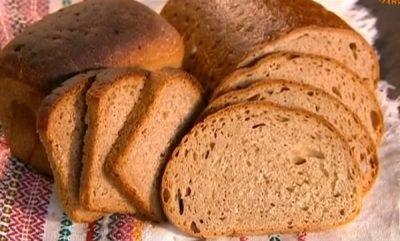
Harm to health can occur from excessive consumption of flour products:
- indigestion in the form of heaviness in the stomach, increased gas formation;
- bowel dysfunction - constipation;
- gaining excess weight;
- exacerbation of chronic gastrointestinal diseases - ulcers, pancreatitis, gastritis.
Darnitsa bread has been and remains one of the favorite types of bakery products; there is hardly a person who has never tried this product. It is respected because of its traditional mild taste, optimal composition and low cost. The main thing is to focus on quality criteria when choosing.
Didn't find the answer to your question? Find out how to solve your particular legal problem - call right now:
Darnitsky bread - calories
Darnitsa bread is baked from rye-wheat flour. It combines the beneficial properties of both wheat and rye grains. The recipe for Darnitsa bread was created even before World War II in Leningrad. This bread should have a pleasant sour taste, a pronounced aroma and a finely porous crumb structure.
Composition and properties of Darnitsa bread
This bread contains a number of vitamins, microelements, natural organic short-chain acids, soluble and insoluble dietary fiber. They help improve digestion and cleanse the body of various toxicants. Regular consumption of Darnitsa bread reduces cholesterol, reduces the risk of cardiovascular diseases, improves the condition of hair, nails and skin, and reduces the likelihood of developing cancer.
Rye, which is part of this bread, helps strengthen the nervous system, improves mood, and helps overcome depression.
The benefits and harms of Darnitsa bread
The benefits of Darnitsa bread lie mainly in high-value rye dietary fiber. They contribute to the formation of intestinal microflora and improve the body's immune system. Many scientists prove the benefits of rye for the human body. Wheat flour, which is part of Darnitsa bread, contains manganese, copper and selenium, as well as B vitamins and valuable vegetable protein. Thanks to the right combination of wheat and rye flour, this bread is perfectly absorbed by the body.
How many calories are in Darnitsa bread?
The calorie content of Darnitsa bread, in comparison with many other types of bakery products, is quite low. The calories of Darnitsa bread per 100 grams of product are 206 kcal. This bread is low in fat, only 1%, and has the same amount of carbohydrates. Therefore, Darnitsa bread can even be included in the diet.
Related articles:
| Calorie content of borscht with pork Borscht is loved not only by the Eastern Slavs, whose traditional dish it is, but also by many other peoples. This article will tell you about the calorie content of borscht with pork. | Beef tongue - calorie content For those who adhere to the principles of dietary nutrition, the issue of calorie content is important and necessary for the correct preparation of the diet. This article will tell you about the calorie content of beef tongue. |
| Calorie content of borscht with chicken As you know, the classic recipe for borscht involves the use of pork, but there is a more dietary version of this dish - borscht with chicken, the calorie content of which will be discussed in this article. | The benefits of buckwheat for the body Much is known about the benefits of various cereals. This article will tell you about the benefits of buckwheat for the human body, its properties, as well as what beneficial substances it contains. |
womanadvice.ru
Characteristics and composition
A high-quality Darnitsa bar should not have lumps, compactions or voids. The main characteristics of the product are as follows:
- The shape of the bun can be rectangular, round or oval. Most often this variety is found in the form of a block.
- Its taste is slightly sour.
- The color is brown with a gray tint. Sometimes you come across beige-gray or milky pulp.
- The weight of 1 piece is 340 or 700 g.
- The aroma is quite strong, with a sour (rye) smell.
Rye and wheat flour were used in the manufacture of this product. The first Darnitsa bar was baked with natural leaven, but later it was replaced with dry yeast. The dough also contains water and salt.
Table Calorie content of Bread 100 g and 1 piece
Since bread is a high-calorie product in any case, you just need to take into account the calorie content of a piece of bread. To do this, it is not necessary to weigh each piece of bread; it is enough to make simple mathematical calculations. An average piece of bread weighs 30-40 grams, so you can simply divide the calorie content figure, which is usually indicated in relation to 100 grams of product, by two.
| Name | Calorie content per 100 g |
| Wheat flour loaf | 235 kcal |
| Pancake flour (pancake flour) | 333 kcal |
| Pancake with cottage cheese | 162 kcal |
| Pancake with mushrooms | 200 kcal |
| Pancake with meat | 186 kcal |
| Pancake with chicken and rice | 169 kcal |
| Butter bun | 300 kcal |
| Hot dog bun | 266 kcal |
| Burekasi with cabbage | 393 kcal |
| Burekas with liver | 404 kcal |
| Burekas with jam | 412 kcal |
| Burekas with meat | 373 kcal |
| Burekasi with onion and egg | 354 kcal |
| Croissant with caramel | 298 kcal |
| Croissant with cabbage | 377 kcal |
| Coffee croissant | 346 kcal |
| Wheat flour | 334 kcal |
| Rye bran | 212 kcal |
| Wheat bran | 260 kcal |
| Blueberry pie (pie with blueberries) | 196 kcal |
| Strawberry pie (pie with strawberries) | 221 kcal |
| Pie with lingonberries | 242 kcal |
| Fried pie with liver | 336 kcal |
| Pie fried with onion and egg | 248 kcal |
| Pie with cabbage | 246 kcal |
| Pie with fish | 227 kcal |
| Pie in Ural style | 178 kcal |
| Drying | 341 kcal |
| Cream crackers | 398 kcal |
| Rye crackers (Finnish) | 320 kcal |
| Wheat-oat crackers (well done bread) | 295 kcal |
| Wheat-buckwheat crackers (well done bread) | 280 kcal |
| Puff pastry without yeast | 487 kcal |
| Crackers with cranberries (Doctor Korner) | 330 kcal |
| Cereal crackers (Doctor Korner) | 312 kcal |
| Black bread 1 piece (30 gr.) | 214 kcal 65 kcal |
| White wheat bread 1 piece (30 gr.) | 223 kcal 68 kcal |
| Borodino bread 1 piece (30 gr.) | 208 kcal 63 kcal |
| Chusovsky dark bread 1 piece (30 gr.) | 212 kcal 64 kcal |
| Malt bread 1 piece (30 gr.) | 281 kcal 85 kcal |
| Kaiser bread 1 piece (30 gr.) | 271 kcal 82 kcal |
| Corn bread with seeds 1 piece (30 gr.) | 290 kcal 88 kcal |
| Rye bread made from peeled flour 1 piece (30 gr.) | 189 kcal 57 kcal |
| Rye bread made from wallpaper flour 1 piece (30 gr.) | 181 kcal 55 kcal |
By the way, there is even a special “bread” diet, which was developed by Israeli doctor Olga Raz.
| Type of bread | Calorie content (per 100 g.) |
| Black bread | 202 kcal |
| White bread | 265 kcal |
| Rye bread | 205 kcal |
| Wheat bread | 242 kcal |
| Bran bread | 227 kcal |
| Bread with seeds | 302 kcal |
| Yeast-free bread | 180 kcal |
| Corn bread | 266 kcal |
| Toast bread | 290 kcal |
Depending on the raw materials and cooking method, each type of bread contains a certain amount of calories. Yeast-free bread is considered the lowest in calories, followed by black, rye and bran. The remaining options will be significantly higher in calories, and therefore less beneficial for the figure.
It is not difficult to calculate how many calories are contained in 1 piece of bread. Pay attention to the thickness of a slice of factory-cut bread. Such a piece will weigh approximately 35 grams. Therefore, to simplify calculations, divide the calorie content per 100 grams by 3.
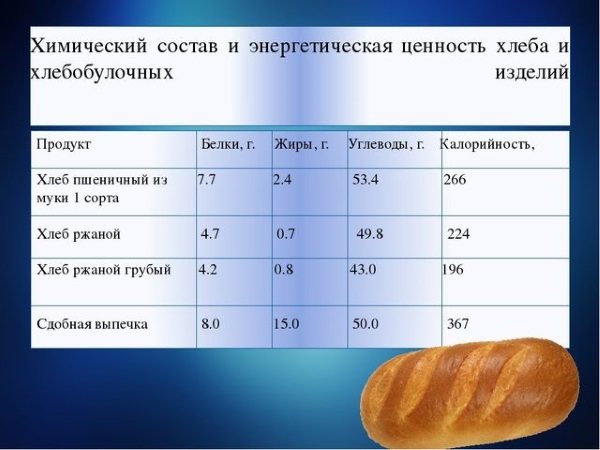
The table shows how many calories are in different types of bread.
https://www.youtube.com/watch?v=CMoTVERJygg
Example: bran bread contains 227 kcal per 100 g. This means that 1 piece of such a product will contain 227/3 = 75.7 kcal. A slice of toast bread will contain 96.7 kcal (290/3=96.7). Thus, if you replace toast bread in your diet with yeast-free bread, you can “lighten” your diet by 21 kcal.
Benefit for health

Peeled (rye) flour has a brown tint, which is transmitted to the crumb. It contains a large number of useful substances, among which are the following:
- Folic acid. Stimulates the production of hormones and ensures sexual health.
- Biotin improves the condition of skin, nails and hair.
- Microelements - magnesium, potassium, calcium and iodine - are involved in creating the immune system and significantly strengthen the body's resistance.
It also contains first grade wheat flour. It has a yellowish tint and a high gluten content.

The crushed grain shells complement the product with a number of elements important for health.
- It contains all B vitamins, which are responsible for the coordinated functioning of the nervous system and digestive organs.
- Vitamins H and PP are involved in the process of cell renewal of all tissues of internal organs.
- Microelements – iron, zinc, sulfur and sodium.
Baking from wheat helps people with high acidity and stomach pain. Thanks to rye flour, the calorie content of Darnitsa bread per 100 grams of product barely exceeds 200 kilocalories.
Darnitsky bread calorie content. How many calories are in Darnitsky bread
The calorie content of Darnitsa bread per 100 grams is 206 kcal, in comparison, the calorie content of white bread is 265 kcal.
1 piece of Darnitsa bread contains 76 kcal, the average weight of which is 30-40 g. Fans of healthy eating often ask the question: “How many calories are in Darnitsa black bread?” We can answer boldly: “A little! This is an ideal product for dietary nutrition."
Nutritional value of Darnitsa bread
Nutritional value of Darnitsa bread per 100 grams:
- Proteins – 6.6 g.
- Fats – 1.1 g.
- Carbohydrates – 41 g.
- Dietary fiber – 6.4 g.
- Minerals – 6.4 g.
Useful properties of Darnitsky bread
Having analyzed the calorie content of Darnitsa bread, we can now analyze its beneficial properties.
The main components of Darnitsa bread: rye and wheat flour
- Rye strengthens the nervous system, immunity and intestinal microflora. And the most important beneficial property of Darnitsa bread is that it improves your mood!
- It is believed that due to less bread consumption, the risk of cancer has become higher. But in vain, the calorie content of Darnitsa bread is low. In European countries it is considered one of the dietary products. Selenium contained in millet flour helps eliminate the threat of cancer. In addition, it is a source of copper and manganese. The nutritional properties of Darnitsa bread do not end there. It contains valuable vitamin B, a number of microelements and fiber.
Due to the ideal mixture of millet and rye flour, it is easily absorbed by the body.
Calorie content of the product
100 g contains: 206 kilocalories, 41 g of carbohydrates, about 6 g of protein and 1.1 g of fat. The calorie content of black Darnitsa bread is not so high. For example, white wheat has 223 kcal, malt - 281, and corn - 290. White with the addition of oatmeal - 278 kilocalories, and mustard - about 300. White with raisins or nuts has an even higher calorie content. Its energy value sometimes exceeds 340 kilocalories, depending on the number of additional components.
Thus, of all similar products, Darnitsa bread has the lowest calorie content. If you refuse additives in the form of butter, sausage or cheese, then rye bread can be safely consumed during a weight loss diet. A regular lunch piece weighs no more than 30 g.
Despite the fact that Darnitsa bread is sold in every store, it is often prepared at home.
How many calories are in crackers made from white and black bread?
| The product's name | Squirrels (g.) | Fat (g) | Carbohydrates (g) | Calorie content of a piece per 100 g. |
| Wheat crackers | 11,2 | 1,4 | 72 | 330 |
| Rye crackers | 11,1 | 1,3 | 70 | 335 |
| Confectionery crackers | 12 | 1,5 | 82,2 | 411 |

Bread is a high-calorie food
How to cook

At home, they try to expand the range of ingredients in order to improve the taste of the future product. To do this, honey, brown sugar and vegetable oil are added to the dough. You will need:
- One tablespoon of liquid honey.
- One and a half glasses of clean water.
- Flour (1 cup rye and 1.5 cups wheat).
- Dry sourdough (6 g) and salt.
Bread is baked both in the oven and in a bread machine. All the necessary products according to the recipe are added to a special form. Sugar and salt are placed in different corners so that they do not touch. Yeast is placed in the middle of the mixture. The mold is secured as tightly as possible and closed with a lid. The color of the crust and the volume of the product are further adjusted. After the dough is kneaded, check it and add water if necessary. You can know when the bun is ready using the timer.
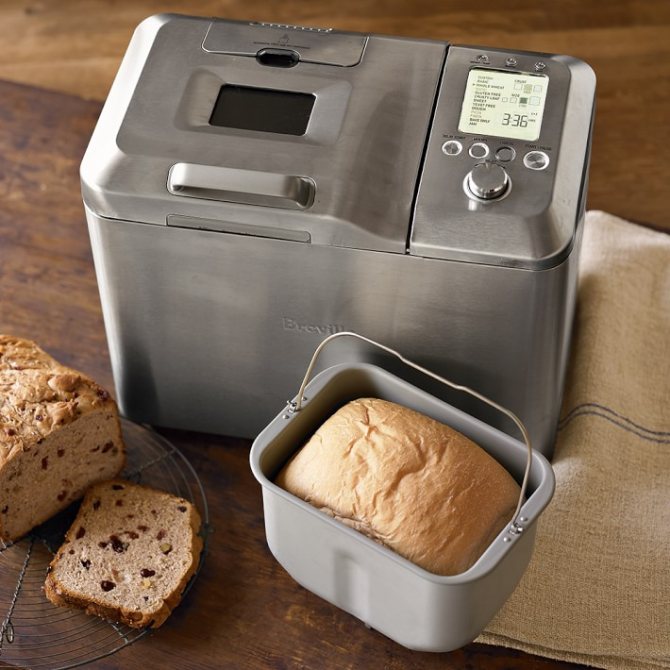
Without honey, the calorie content of a piece of Darnitsa bread is 90 kilocalories. With additional components it increases by 10-20 kcal.
Thus, preparing Darnitsa bread will not be difficult and will take very little time. Thanks to home baking, you can save money and protect yourself and your family from unscrupulous manufacturers.
Calorie content of black bread of different varieties
When visiting a nutritionist, many people ask the question: how many calories are in one piece of black bread, and whether it can be consumed as food, especially if there are problems with excess weight. Most likely, you will be told that black bread contains from 180 to 300 calories, because it is difficult to give an unambiguous answer to this complex question. This depends on many factors, including what you are used to eating bread with. The most popular varieties of rye bread are Borodinsky and Darnitsky, so the question of how many calories are in Borodinsky bread sounds quite often, and people also want to know how many calories are in Darnitsky bread.
If you love these types of bread and consume it within reasonable limits, you don’t have to worry about your figure - on average, this is 200 calories per 100 grams of product. It should not be forgotten that a piece of bread weighs on average 40 grams. Another question is if you like bread with tasty additives such as butter. If you really care about your figure, then you should know how many calories are in black bread and butter. Studies have shown that a piece of bread for a standard sandwich requires about 12-13 grams of butter, and the calorie content of such a piece of butter with 73% fat is about 90 calories. To understand how high-calorie it is, calculate how many “kilograms” 100 grams of such a product weigh.




